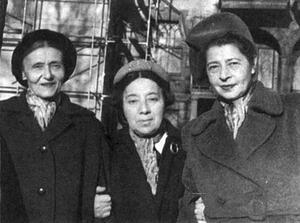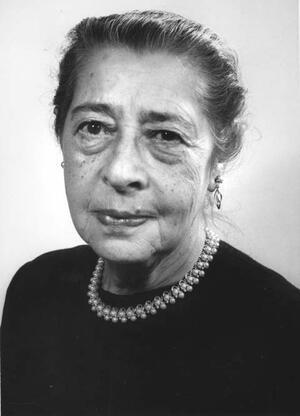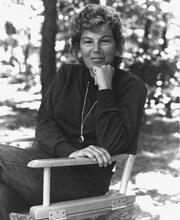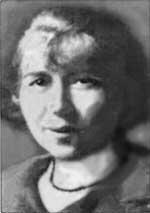Rokhl Häring Korn
Born in Galicia, Rokhl Häring Korn fled to Vienna during World War I before settling in Przemysl in 1918, the year she published her first works in Zionist and socialist papers. In 1920, dismayed by escalating pogroms, she asked her husband to teach her Yiddish so that she could write in a Jewish language instead of Polish. She published her first collection of poetry in 1928, publishing eight volumes of poetry and two collections of fiction during her career. In 1941, fleeing the German invasion, Korn left Poland for Moscow, eventually immigrating to Montreal in 1948. She continued writing throughout her many moves, and while her early work was noted for its nature imagery, her later writing often focused on themes of homelessness and the upheaval of war.
Overview and Early Life
Rokhl Häring Korn is a major figure in modern Yiddish literature. Her early work established her reputation as a brilliant narrative writer in verse and prose and a passionate lyric poet. In her later work, she developed into a poet of complex, sustained meditation, with a remarkable ability to turn her life into symbol. In the course of her writing career she published eight volumes of poetry and two collections of fiction.
Korn was born on the farming estate Sucha Gora (Dry Mountain) near Podliski, East Galicia on January 15, 1898, the eldest of three children and only daughter of Chana (Fast, d. 1942) and Wolf Häring (d. 1908), a landowner. Her brothers were Hersh (1902–1942) and Lezyer (1908–1941). Her family on both sides had owned and managed farmland for several generations. Her father died of tuberculosis when she was ten, but her mother continued to manage the farm with the help of a steward. Korn describes the lives of her parents in the two completed chapters of her memoir My Home and I and in a number of autobiographical poems. Later in life she discovered that her father had written poetry and philosophical essays in Hebrew, an indication to her that she had inherited the inclination to be a writer from him. But her loneliness as a child was the immediate stimulus to her imagination. Growing up on an isolated farm in an area with very few Jewish families, she peopled her world with the living things around her and began to write poetry. “Writing for me was a remorseless necessity,” she says (Korman 1928). She was educated mainly in Polish, the language of her household. After some years of working with a private tutor at the farm, she joined a group of students who were being tutored in the (Yiddish) Small-town Jewish community in Eastern Europe.shtetl Mościce, where she read some of the classics of Polish literature. When World War I broke out, her family fled the Galician battle zone. They spent the four years of the war in Vienna and returned to live in Przemysl from 1918 to 1941.
Early Writing Career
Korn’s first publications were in Polish in 1918, in Nowy Dziennik, a Zionist newspaper, and in Glos Przemyski, a socialist journal, but pogroms against the Jews of Poland after the war led her to write in Yiddish, though she had to be taught to speak, read, and write the language by her husband Hersh Korn (1895–1943), a “Left” Labor Zionist whom she married in 1920.
In 1919, Korn published her first Yiddish poem in the Lemberger Tageblatt. Throughout the 1920s and 1930s she was a steady contributor to Yiddish literary journals and newspapers. With the publication of her early volumes of poetry, Dorf (Village, 1928) and Royter mon (Red Poppies, 1937), and her first collection of stories, Erd (Land, 1936), she was recognized as an accomplished and original writer. The profusion and directness of her nature imagery, the dramatic confrontations of village life as she pictured it and the intensity of her love poetry were all new to Yiddish literature.
During the years of the Nazi-Soviet pact (1939–1941), Korn became a Soviet citizen and joined the Soviet Writers’ Union. In June 1941, shortly before the Germans invaded, Korn left her home in Przemysl to be with her daughter Irena (b. 1922), who was studying medicine in Lvov. When the bombing began, they escaped into the Soviet Union. They had no time to contact Korn’s husband, her mother, her brothers, or their families, all of whom perished in the war.
Korn had been left-wing in her political sympathies, but in the Soviet Union she was profoundly alienated by the communist state and turned down the offer of a job as a journalist for a Yiddish newspaper. She and her daughter fled from Kiev to Uzbekistan, where Korn suffered hunger and had to be hospitalized with pellagra. In 1943, her daughter left to attend medical school in Moscow. Korn joined her the next year. In Moscow, she was welcomed as a colleague by the leading figures in the world of Soviet Yiddish culture and during her two years there she wrote some of her most powerful Holocaust poems.
Post-Holocaust Career
Korn and her daughter returned to Poland in 1946 and settled in Łódź. Korn was chosen by the Yiddish Writers’ Union as their delegate to the PEN conference in Stockholm and remained in Sweden, hoping to find a way to emigrate. With the help of the Canadian Yiddish writer Ida Maze, she was able to obtain the necessary visas and in 1948 Korn, her daughter, and her son-in-law immigrated to Canada and settled in Montreal.
Korn called this part of her life her “na v’nod,” the years of her wandering. The dislocation, loss, and anguish of these years are at the forefront of her mind in her first postwar collection of poems, Heym un heymlozikayt (Home and Homelessness, 1948).
Korn continued to write and to develop as a poet for the next three decades. In later volumes, like Fun yener zayt lid (On the Other Side of the Poem, 1962), she moved on to a more symbolic style and a new dependence on “the word,” on the poem itself, which supplanted the home she had lost.
Among the numerous prizes the Yiddish literary world awarded her were the Louis Lamed Prize for poetry and prose (1950 and 1958), the Jewish Book Council of America Certificate of Honor and Award for Yiddish Poetry (1969), the H. Leivick Prize (1972) and the Manger Prize of the State of Israel (1974). Her poetry and some of her stories have been translated into English, French, German, Hebrew and Polish.
Korn as a strikingly intelligent and feeling writer whose work continued to develop in style and theme throughout her career. Her early writing was grounded in acute observation of the natural world, passionate honesty about the people she knew and remarkable openness about herself. As a story writer she was harsh, dramatic and unflinching. During and after World War II, homelessness became a major theme in her work. She now felt the obligation to speak for the Jewish people destroyed in the war. She saw herself as an eternal debtor to those who perished. In her later poems, she moved from narrative to a tighter, more symbolic style, from exterior to psychic landscapes. This change in style enabled her to generalize her own experience of loss, to turn her life into symbol. Even in her last volume of poems, written after she suffered a massive coronary, she turned the suffering of her own mind and body into a potent symbol of a larger suffering.
Rokhl Häring Korn died in Montreal on September 9, 1982.
Selected Works
Poetry, Fiction
Dorf, lider (Village, poems). Vilna: 1928.
Erd, dertseylungen (Land, stories).Warsaw: 1936.
Royter mon, lider (Red Poppies, poems). Warsaw: 1937.
Heym un heymlozikayt, lider (Home and Homelessness, poems). Buenos Aires: 1948.
Bashertkayt, lider 1928–48 (Fate, poems 1928–48). Montreal: 1949.
Nayn dertseylungen (Nine Stories). Montreal: 1957.
Fun yener zayt lid (On the Other Side of the Poem). Tel Aviv: 1962.
Di gnod fun vort (The Grace of the Word) Tel Aviv: 1968.
Oyf der sharf fun a rege (The Cutting Edge of the Moment). Tel Aviv: 1972.
Farbitene vor, lider (Altered Reality, poems). Tel Aviv: 1977.
Memoirs
“Biografie” (Biographical Note) in Yidishe dikhterins antalogie (An anthology of Yiddish Women Poets), E. Korman, ed. Chicago: 1928.
A revealing statement about Korn’s early life and the impulse to write poetry.
“Dos bukh iz gevidmet ale mayne toyte” (This book is dedicated to all my dead), Korn’s introduction to Heym un heymlozikayt.
A brief account of the destruction of her family in the Holocaust.
Mayn heym un ikh (My Home and I): “Dos naye hoyz” (The New House), Pakntreger (Book Peddler), bilingual format, No. 35 (Winter 2001) and “Dos roz-geshtrayfte zekele” (The Sack with Pink Stripes), Yiddish ms. unpublished, English translation in Beautiful as the Moon, Radiant as the Stars, New York: 2003.
Two chapters of an unfinished autobiographical memoir. “Dos naye hoyz,” written mainly from a child’s point of view, is an account of the building of the house where Korn spent most of her childhood; “Dos roz-geshtrayfte zekele” tells the story of her mother’s thwarted engagement to the man she loved and dutiful marriage to the man her family chose for her.
Essays, Interview
Korn published numerous essays on Yiddish writers in Yiddish literary journals. Many of these essays, collected under the title Portretn fun yidishe shrayber (Portraits of Yiddish Writers), are available at the Rokhl Korn Archive, Jewish Public Library, Montreal.
Some of Korn’s observations about her values and aims as a writer are included in the following:
“Rekordirte geshprekh vegn poezie tsvishn A. Tabatshnik un Rokhl Korn” (Rokhl Korn and A. Tabatshnik: A recorded conversation on poetry). Zayn (Being) 12/48 (February 1967): 18–26.
This conversation is remarkable for what it reveals of Korn’s imagination and personality. Especially valuable are Korn’s comments on the purpose of poetry and the creative process as she experienced it.
“A vort baym bakumen dem Manger-prayz” (A Word on Receiving the Manger Prize). Di goldene keyt (The Golden Chain), 84–85 (1974): 146–148.
Reflections on Itzik Manger’s poetic technique. Includes an important statement on the use of the Holocaust as a subject for poetry.
“Mayn dank” (My Thanks). Yidishe kultur (Yiddish Culture) 43 (November–December 1981): 27.
Korn’s response upon being awarded the Zhitlovsky Prize. A brief statement that includes a thoughtful defense of literature in an age of technology.
Collections of Poetry and Prose in Translation
Lider un erd/Shirim ve-Adamah (Poems and Land) (Yiddish/Hebrew). Bilingual format. Trans. Shimshon Meltzer. Tel Aviv: 1966.
Generations: Selected Poems of Rokhl Korn. Ed. Seymour Mayne. Trans. R. Augenfeld, S. Mayne et al. Oakville, Ontario: 1982.
Paper Roses: Selected Poems of Rokhl Korn, A Bilingual Edition/Papirene royzn: geklibene lider fun Rokhl Korn, tsveyshprakhike oysgabe. Ed. and trans. Seymour Levitan. Toronto: 1985.
Selected Poetry and Prose In Anthologies
An Anthology of Yiddish Women Poets (Yiddish). Chicago: 1928.
An Anthology of Yiddish Prose in Poland between the Two World Wars (1914–1939) (Yiddish). New York: 1949.
A Treasury of Yiddish Poetry. New York: 1969.
An Anthology of Modern Yiddish Literature. The Hague: 1974.
Canadian Yiddish Writings. Montreal: 1976.
The Poets of Canada. Edmonton: 1978.
The Penguin Book of Women Poets. New York: 1979.
Voices Within The Ark: The Modern Jewish Poets. Yonkers: 1980.
The Spice Box: An Anthology of Jewish Canadian Writing. Toronto: 1987.
The Penguin Book of Modern Yiddish Verse. New York: 1987.
Canadian Jewish Stories. Toronto: 1990.
Truth and Lamentation: Stories and Poems on the Holocaust. Urbana: 1994.
Found Treasures: Stories by Yiddish Women Writers. Toronto: 1994.
The Last Lullaby: Poetry from the Holocaust. Syracuse: 1998.
When Night Fell: An Anthology of Holocaust Short Stories. New Brunswick: 1999.
Not Quite Mainstream: Canadian Jewish Short Stories. Calgary: 2001.
No Star Too Beautiful. New York: 2002.
Beautiful as the Moon, Radiant as the Stars. New York: 2003.
Unpublished Translations
“Mageyfe in dorf” (An Epidemic in the Village), “A shed in feld” (A Demon in the Field), “Der letster veg” (The Last Road). In Nayn dertseylungen (Nine Stories). Montreal: 1957. Trans. S. Levitan.
Cassette Tape Recording, Website
Paper Roses, Yiddish Poems by Rokhl Korn/ Papirene royzn, yidishe lider fun Rokhl Korn. A dual language recording by Global Village. New York: 1989.
This cassette is based on a tape recording of Korn reading her poems in 1981, a year before her death.
Rokhl Korn Website. www.Rokhlkorn.com and www.jewishpoetry.org
Biographical
Fuchs, Khaim Leib. 100 yor yidishe un hebreyishe literatur in kanade (100 Years of Yiddish and Hebrew Literature in Canada). Toronto: 1979.
Korn, B., E. Naks, and E. Shulman, eds. Leksikon fun der nayer yidisher literatur (Lexicon of the New Yiddish Literature) Vol. 8. New York: 1981.
Levitan, Seymour. “Rokhl Korn.” Encyclopedia of Literature in Canada. Toronto: 2002.
Reyzn, Zalmen. Leksikon fun der yidisher literatur, prese, un filologie (Lexicon of Yiddish Literature, Press and Philology), vol. 3. Vilna: 1929.
Critical
Bikl, Shloyme. Shrayber fun mayn dor, driter band. (Writers of My Generation, Vol. 3) Tel Aviv: 1970.
Elberg, Yehuda. “Rokhl Korn in lider un dertseylungen” (Rokhl Korn in poems and stories). Di tsukunft (The Future) 101/3 (May–June 1996): 9–18.
Glatshteyn, Yankev. In tokh genumen (Sum and Substance). New York: 1956.
Glatshteyn, Yankev. Af grete temes (On Matters Near at Hand). Tel Aviv: 1967.
Glatshteyn, Yankev. “Rokhl Korns kleyne antalogie” (Rokhl Korn’s Little Anthology). Review of Lider un erd. Zayn (Being) 12/48 (February 1967): 5–8.
Goldberg, Itche. “Fun yener zayt lid” (On the Other Side of the Poem). Di goldene keyt (The Golden Chain) 135 (1993): 136–148.
Gros-tsimerman, Moyshe. Dos vort vos mir shraybn. (The Word That We Write). Tel Aviv: 1971.
Gros-tsimerman, Moyshe. Intimer videranand: eseyen (Intimate Disputation: Essays). Tel Aviv: 1964.
Levitan, Seymour. “Canadian Yiddish Writers.” In Identifications: Ethnicity and the Writer in Canada, edited by Jars Balan. Edmonton: 1982.
Levitan, Seymour. “Introduction,” “A Note on the Translations.” In Paper Roses: Selected Poems of Rokhl Korn, A Bilingual Edition. Toronto: Aya Press, 1985.
Orenstein, Eugene. “Rokhl Korn.” Yidishe kultur (Yiddish Culture) 44 (October 1982): 7–10.
Orenstein, Eugene. “Yiddish Culture in Canada, Yesterday and Today.” In The Canadian Jewish Mosaic, edited by M. Weinfeld, W. Shaffir, and I. Cotler. Rexdale, Ontario: 1981.
Oyerbakh, Rokhl. “Rokhl Korn. Portret, varshe 1933” (Rokhl Korn. Portrait, Warsaw 1933). Di tsukunft (The Future) 84, no.1 (January 1978): 20–22.
Ravitch, Melekh. Mayn Leksikon: yidishe dikhter, dertseyler, dramaturgen in poyln tsvishn di tsvey groyse velt milkhomes, Band 1 (My Lexicon: Yiddish Poets, Story-tellers, Playwrights in Poland between the Two World Wars, Vol. 1). Montreal: 1945.
Rosenfarb, Chava. Yiddish Poets in Canada. Mississauga: 1974.
Seelig, Rachel. “Like a Barren Sheet of Paper: Rokhl Korn from Galician Orchards to Postwar Montreal.” Prooftexts, vol. 34, no. 3 (2014): 349-377.
Waddington, Miriam. Apartment Seven. Toronto: 1989.
Wiesel, Elie. “Fun yener zayt lid—a nay bukh fun Rokhl Korn” (On the Other Side of the Poem—a new book by Rokhl Korn). Book review. The Forward, November 16, 1962.
Wiesel, Elie. “In Praise of Rokhl Korn.” Generations: Selected Poems of Rokhl Korn. Oakville, Ontario: 1982.






